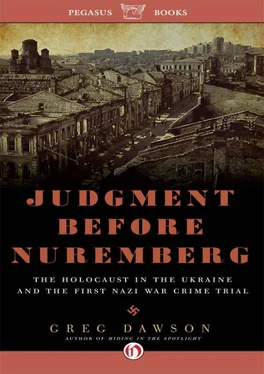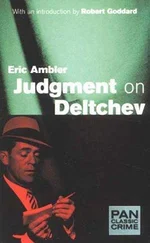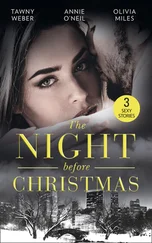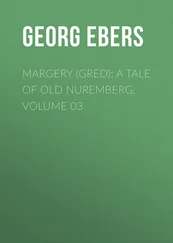I shudder to imagine my mother listening as the tour guide told how in summer there were strawberries and cranberries growing in the ravines, but when she looked at them all she could think of was blood. Worst of all would have been the subterranean “Mourning Hall” where on a wall engraved with the names of the dead she would have found the names of her grandparents, her parents, Dmitri and Sarah—and also her own and her sister’s. I am certain that no flicker of triumph at having cheated fate would have mitigated the horror of that moment for my mother. She might, however, have found some solace at the Kharkov Holocaust Museum. And though I might have originally gone to Ukraine for Hiding in the Spotlight , it was at the museum that I found the inspiration for this book.
The museum is housed in three high-ceilinged rooms on the second story of a pre-war building on Petrovskogo Street in downtown Kharkov. When opened in 1996 without government support by a band of Jewish activists led by Larisa Volovik, it became—and remains to this day—the only public Holocaust museum in Ukraine. That startling fact speaks volumes about denial of the Holocaust in the country where the mass extermination of Jews first began in 1941. That changed with the dissolution of the Soviet Union in 1991. It’s no longer official policy to pretend the Holocaust happened to 6 million random people of no particular ethnic or religious identity. There has been a revival of Jewish life. In Kharkov I visited the synagogue and several thriving Jewish organizations that offer books and programs on the Holocaust. It’s now taught in the schools. But there is still a long way to go.
I wish my mother had been with us the day we visited the museum in 2006. Volovik had put a story in the museum’s monthly publication about our upcoming research trip to Ukraine. When we arrived, there were two surprise guests waiting for us whose presence refuted my facile assertion to Candy that there was no one left in Kharkov who knew my mother. These two gray-haired women—sisters—did. But they knew Zhanna only as Anna Morozova, the fictitious name she used during the war while trying to hide her Jewish identity
Through a translator, the sisters explained that they had been in an entertainment troupe with Anna (Zhanna) and Marina (Frina) that performed for Nazi troops occupying the city of Kremenchug in central Ukraine. One of them gave us a picture she had taken of the troupe. My mother is in the middle of the large group, the only one looking away from the camera, in hopes of not being noticed. Frina had stayed in her room and refused to be in the photo.
The museum offered a variety of artifacts—eyeglasses, pocket watches, lockets—documents, photos, and exhibits, including a scale model of the abandoned tractor factory outside Kharkov where the doomed Jews were held for two weeks without food and water in late December 1941 before being marched to Drobitsky Yar.
Another exhibit that caught my eye featured a series of black-and-white photos. There were images of a courtroom, close-ups of various individuals, and—most striking—photos of a public execution, four men hanging by their necks at the end of long ropes. A huge crowd, thousands, surrounded the rough gallows in what appeared to be a public square. The accompanying text said the four men were three Nazi officers and a Russian collaborator. They had been tried by Soviet authorities in a makeshift courtroom in the Kharkov Opera House and been found guilty of heinous crimes against the people of Ukraine. I looked at the date under the photo of the hangings.
December 19, 1943.
I looked again—that couldn’t be right. 1943? The war in Europe didn’t end till May 1945. The war crime trials in Nuremberg began that November.
How was it possible, I wondered, that there was a Nazi war crime trial in Ukraine nearly two years before Nuremberg and that there seemed to be no record of it except this exhibit?
But then, how was it possible that nearly a million Ukrainian Jews were murdered before the chimneys at Auschwitz began belching human ash, and almost no one seemed to know about that either?
Near the photo exhibit of the trial was a glass case with two faded red ticket stubs, good for admission to the Kharkov Opera House, December 13, 1943, for a trial now as forgotten as the million Jews who, in the words of NBC anchor Brian Williams sixty-five years later, “simply vanished” from Ukraine.
“Somebody,” I thought, “needs to do a book about that someday.”
History has done Holocaust deniers a great favor by largely deleting Ukraine from our collective memory and common knowledge. What makes the omission as significant as it is tragic is not just the fact that more than a million Jews in Ukraine were murdered; it’s the fact that these were the first of the 6 million. Ukraine is where the mass extermination of the Jews began, not Poland or Germany as nearly all Americans still believe.
The analogy is imperfect but will suffice: not placing Ukraine high up in Chapter 1 of the story of the Holocaust would be like teaching U.S. involvement in World War II by skipping Pearl Harbor and going straight to D-Day. The analogy is further imperfect because what Hitler did in Ukraine, and why, explains far more about the Holocaust than Pearl Harbor does about the war with Japan. Motive, weapons, plan—all the incontrovertible evidence of the greatest crime of the twentieth century is to be found at the start, in Ukraine. Allowing fate and circumstance to effectively quash the evidence—disconnecting the dots between motive and crime—helps deniers spread their fantasies in the court of public opinion.
I was not a student of the Holocaust—or much of anything, I’m sure my teachers would say—before writing Hiding in the Spotlight. I spent more time at the library doing research for the book than I did in all my years of high school and college combined. I was startled by what I found. I had gone in search of basic Holocaust history that would form the backdrop for my mother’s story of escape and survival. I found the first hours of the Final Solution—Operation Barbarossa. On June 22, 1941, three million German troops and three thousand tanks invaded the Soviet Union. Following behind the Wehrmacht were mobile killing squads, Einsatzgruppen, whose specific mission was to find and kill Jews in large numbers, the start of the fulfillment of Hitler’s malignant vision. By the end of the year, months before the gas chamber doors at Auschwitz would swing open, half a million Ukrainian Jews were already dead.
I was surprised by this information, but even more surprised—dumbfounded—that it was news to virtually everyone who heard it from me at events where I spoke about Hiding in the Spotlight. Between June 2009 when the book came out and January 2011, I made some 120 presentations at churches, synagogues, service clubs, retirement homes, private homes, middle schools, universities, museums, libraries, and bookstores in Florida, Georgia, Virginia, and Indiana. It would be generous to say that 10% of the listeners had a clue about the events in Ukraine in 1941.
At a middle school in Bloomington, Ind., my hometown, the percentage was half that, and would have been lower if I weren’t such an easy grader. Before my wife and I visited the school to discuss the book and to show Candy’s film about our trip to Ukraine in 2006, I had the teachers give a four-question pop quiz to the eighth-graders we would be addressing. No need for the kids to sign their papers, I told the teachers, I just want to see how much a group of typical middle schoolers knows about the Holocaust in 2010. These were not trick questions. They called for information that would be in chapter one of any history of the Holocaust in Ukraine—if only it were being taught.
Читать дальше












